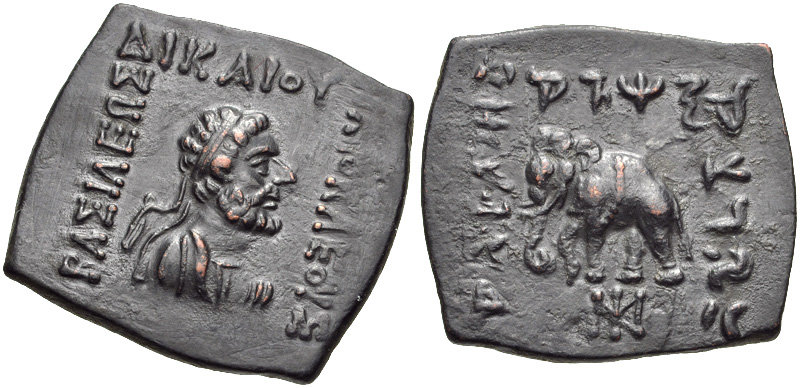Heliocles II on:
[Wikipedia]
[Google]
[Amazon]


 Heliocles II Dicaeus ( Greek: ;
Heliocles II Dicaeus ( Greek: ;


 Heliocles II Dicaeus ( Greek: ;
Heliocles II Dicaeus ( Greek: ; epithet
An epithet (, ), also byname, is a descriptive term (word or phrase) known for accompanying or occurring in place of a name and having entered common usage. It has various shades of meaning when applied to seemingly real or fictitious people, di ...
means "the just") is thought to have been one of the later Indo-Greek kings and a relative of the Bactrian king Heliocles I. Current scholarly consensus is that he ruled ca 95–80 BCE.
Heliocles II seems to have been engaged in a series of wars with Strato I in Gandhara
Gandhāra is the name of an ancient region located in the northwestern region of the Indian subcontinent, more precisely in present-day north-west Pakistan and parts of south-east Afghanistan. The region centered around the Peshawar Vall ...
and Punjab
Punjab (; Punjabi: پنجاب ; ਪੰਜਾਬ ; ; also romanised as ''Panjāb'' or ''Panj-Āb'') is a geopolitical, cultural, and historical region in South Asia, specifically in the northern part of the Indian subcontinent, comprising ...
; the two share several mintmarks and Heliocles II overstruck many of his coins. During this period, a number of kings fought for hegemony in the Indo-Greek territories. Some of them were likely supported by nomad Saka rulers such as Maues
Maues (Greek: ; (epigraphic); Kharosthi: , , called , on the Taxila copper plate; also called , in the Mathura lion capital inscription,) was the first Indo-Scythian king, ruling from 98/85 to 60/57 BCE. He invaded India and establishe ...
.
Genealogy
Heliocles II used a reverse of standingZeus
Zeus or , , ; grc, Δῐός, ''Diós'', label=Genitive case, genitive Aeolic Greek, Boeotian Aeolic and Doric Greek#Laconian, Laconian grc-dor, Δεύς, Deús ; grc, Δέος, ''Déos'', label=Genitive case, genitive el, Δίας, ''D� ...
, who was a common deity among the later Indo-Greek kings. J. Jakobsson sees Heliocles as the son of the important king Antialcidas Nikephoros (whose type was sitting Zeus) and perhaps the grandson of Heliocles I.
He goes on to suggest that Heliocles was the older brother of the king Archebius
Archebius Dikaios Nikephoros (Greek: ; epithets mean respectively, "the Just", "the Victorious"; formerly read as "Archelius") was an Indo-Greek king who ruled in the area of Taxila. Osmund Bopearachchi dates him to c. 90–80 BCE, and R. C. ...
Nikephoros Dikaios, who seems to have succeeded Heliocles II in Gandhara (perhaps after his death from disease; Heliocles I looks emaciated on his later portraits). Archebius uses a very similar reverse and combines the epithets of Heliocles II and Antialcidas; in addition, their coin portraits are similar, with hooked noses and fierce expressions.
R.C. Senior has instead suggested a connection with Demetrius III, who used a similar reverse of standing Zeus.
Coins of Heliocles II
Heliocles II issued Indian silver with portrait (diademed, helmeted or spear-throwing) / standing Zeus and bronzes with bearded diademed portrait (Heliocles or Zeus) / elephant. It is uncertain whether he struck Attic coins. A number of posthumous coins for Heliocles I have been found in Bactria; possibly some of these may have been struck by Heliocles II, though there are no similar monograms.Overstrikes
The existence of numerousoverstrike
In typography, overstrike is a method of printing characters that are missing from the printer's character set. The character is created by placing one character on another one — for example, overstriking "L" with "-" results in printing a "� ...
s helps locate the reign of Heliocles II in relation to other Indo-Greek kings. Heliocles overstruck coins of Agathokleia
Agathoclea Theotropus ( grc, Ἀγαθόκλεια Θεότροπος, Agathokleia Theotropos; the epithet possibly means ''the Goddess-like'') was an Indo-Greek queen married to Menander I, who ruled in parts of northern India in the 2nd-centu ...
, Strato I, and Hermaeus
Hermaeus Soter or Hermaios Soter ( grc, Ἑρμαῖος ὁ Σωτήρ; epithet means "the Saviour") was a Western Indo-Greek king of the Eucratid Dynasty, who ruled the territory of Paropamisade in the Hindu-Kush region, with his capital in Alex ...
. Conversely, Amyntas overstruck coins of Heliocles II. These overstrikes suggest that Heliocles II reigned around 95–85 BCE and was a contemporary of Amyntas and Hermaeus Bopearachchi, "De l'Indus à l'Oxus", p129
See also
*Greco-Bactrian Kingdom
The Bactrian Kingdom, known to historians as the Greco-Bactrian Kingdom or simply Greco-Bactria, was a Hellenistic period, Hellenistic-era Hellenistic Greece, Greek state, and along with the Indo-Greek Kingdom, the easternmost part of the Helleni ...
* Seleucid Empire
The Seleucid Empire (; grc, Βασιλεία τῶν Σελευκιδῶν, ''Basileía tōn Seleukidōn'') was a Greek state in West Asia that existed during the Hellenistic period from 312 BC to 63 BC. The Seleucid Empire was founded by the ...
* Greco-Buddhism
Greco-Buddhism, or Graeco-Buddhism, is the cultural syncretism between Hellenistic culture and Buddhism, which developed between the fourth century BC and the fifth century AD in Gandhara, in present-day north-western Pakistan and parts of nort ...
* Indo-Scythians
Indo-Scythians (also called Indo-Sakas) were a group of nomadic Iranian peoples of Scythian origin who migrated from Central Asia southward into modern day Pakistan and Northwestern India from the middle of the 2nd century BCE to the 4th centur ...
* Indo-Parthian Kingdom
* Kushan Empire
The Kushan Empire ( grc, Βασιλεία Κοσσανῶν; xbc, Κυϸανο, ; sa, कुषाण वंश; Brahmi: , '; BHS: ; xpr, 𐭊𐭅𐭔𐭍 𐭇𐭔𐭕𐭓, ; zh, 貴霜 ) was a syncretic empire, formed by the Yuezhi, i ...
Notes
References
* * * {{DEFAULTSORT:Heliokles 02 Indo-Greek kings 1st-century BC rulers in Asia 2nd-century BC rulers in Asia Diodotid dynasty